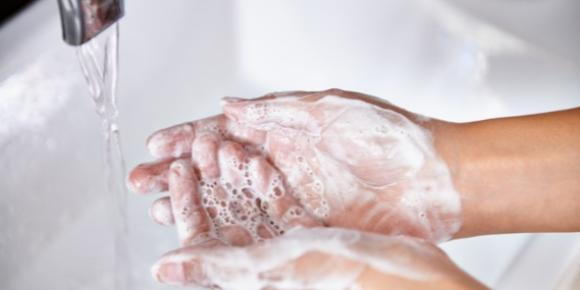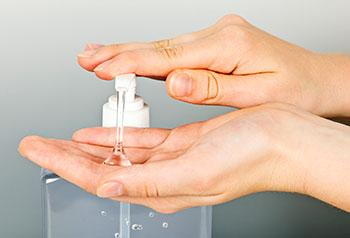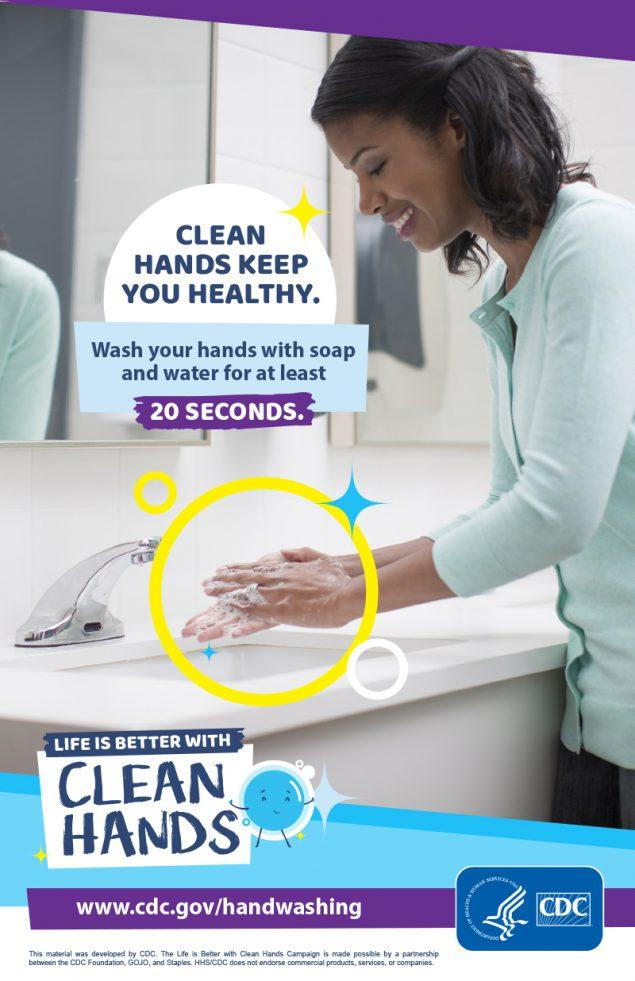
- posted: Oct. 30, 2019
Handwashing is one of the best ways to protect yourself and your family from getting sick. Learn when and how you should wash your hands to stay healthy.
Wash Your Hands Often to Stay Healthy
You can help yourself and your loved ones stay healthy by washing your hands often, especially during these key times when you are likely to get and spread germs:
- Before, during, and after preparing food
- Before eating food
- Before and after caring for someone at home who is sick with vomiting or diarrhea
- Before and after treating a cut or wound
- After using the toilet
- After changing diapers or cleaning up a child who has used the toilet
- After blowing your nose, coughing, or sneezing
- After touching an animal, animal feed, or animal waste
- After handling pet food or pet treats
- After touching garbage
Follow Five Steps to Wash Your Hands the Right Way
Washing your hands is easy, and it’s one of the most effective ways to prevent the spread of germs. Clean hands can stop germs from spreading from one person to another and throughout an entire community—from your home and workplace to childcare facilities and hospitals.
Follow these five steps every time.
- Wet your hands with clean, running water (warm or cold), turn off the tap, and apply soap.
- Lather your hands by rubbing them together with the soap. Lather the backs of your hands, between your fingers, and under your nails.
- Scrub your hands for at least 20 seconds. Need a timer? Hum the “Happy Birthday” song from beginning to end twice.
- Rinse your hands well under clean, running water.
- Dry your hands using a clean towel or air dry them.
The Science behind Washing Hands:
Using soap to wash hands is more effective than using water alone because the surfactants in soap lift soil and microbes from skin, and people tend to scrub hands more thoroughly when using soap, which further removes germs 2,3,7,8.
To date, studies have shown that there is no added health benefit for consumers (this does not include professionals in the healthcare setting) using soaps containing antibacterial ingredients compared with using plain soap 9, 10. As a result, FDA issued a final rule in September 2016 that 19 ingredients in common “antibacterial” soaps, including triclosan, were no more effective than non-antibacterial soap and water and thus these products are no longer able to be marketed to the general public. This rule does not affect hand sanitizers, wipes, or antibacterial products used in healthcare settings.
Use Hand Sanitizer When You Can’t Use Soap and Water
You can use an alcohol-based hand sanitizer that contains at least 60% alcohol if soap and water are not available.
Washing hands with soap and water is the best way to get rid of germs in most situations. If soap and water are not readily available, you can use an alcohol-based hand sanitizer that contains at least 60% alcohol. You can tell if the sanitizer contains at least 60% alcohol by looking at the product label.
Sanitizers can quickly reduce the number of germs on hands in many situations. However,
- Sanitizers do not get rid of all types of germs.
- Hand sanitizers may not be as effective when hands are visibly dirty or greasy.
- Hand sanitizers might not remove harmful chemicals from hands like pesticides and heavy metals.
Caution! Swallowing alcohol-based hand sanitizers can cause alcohol poisoning if more than a couple of mouthfuls are swallowed. Keep it out of reach of young children and supervise their use. Learn more here.
How to use hand sanitizer
- Apply the gel product to the palm of one hand (read the label to learn the correct amount).
- Rub your hands together.
- Rub the gel over all the surfaces of your hands and fingers until your hands are dry. This should take around 20 seconds.
- Do not overuse alcohol based hand sanitizer. Always wash your hands over alcohol based sanitizer.

For more information on handwashing, visit CDC’s Handwashing website or call 1-800-CDC-INFO.

- Palit A, Batabyal P, Kanungo S, Sur D. In-house contamination of potable water in urban slum of Kolkata, India: a possible transmission route of diarrhea.external icon Water Sci Technol. 2012;66(2):299-303.
- Luby SP, Agboatwalla M, Feikin DR, Painter J, Billhimer W, Altaf A, Hoekstra RM. Effect of handwashing on child health: a randomised controlled trial.external icon Lancet. 2005;366:225-33.
- Luby SP, Halder AK, Huda T, Unicomb L, Johnston RB. The effect of handwashing at recommended times with water alone and with soap on child diarrhea in rural Bangladesh: an observational study.external icon PLoS Med. 2011;8(6):e1001052.
- Carrico AR, Spoden M, Wallston KA, Vandenbergh MP. The environmental cost of misinformation: why the recommendation to use elevated temperatures for handwashing is problematicexternal icon. Int J Consum Stud. 2013;37(4):433-41.
- Laestadius JG, Dimberg L. Hot water for handwashing–where is the proof?external icon J Occup Environ Med. 2005;47(4):434-5.
- Michaels B, Gangar V, Schultz A, Arenas M, Curiale M, Ayers T, Paulson D. Water temperature as a factor in handwashing efficacy.external icon Food Service Technology. 2002;2:139-49.
- Burton M, Cobb E, Donachie P, Judah G, Curtis V, Schmidt WP. The effect of handwashing with water or soap on bacterial contamination of hands.external icon Int J Environ Res Public Health. 2011;8(1):97-104.
- Todd ECD, Michaels BS, Holah J, Smith D, Grieg JD, Bartleson CA. Outbreaks where food workers have been implicated in the spread of foodborne disease. Part 10. Alcohol-based antiseptics for hand disinfection and a comparison of their effectiveness with soaps.external icon J Food Prot. 2010;73(11):2128-40.
- Luby SP, Agboatwalla M, Painter J, Altaf A, Billhimer WL, Hoekstra RM. Effect of intensive handwashing promotion on childhood diarrhea in high-risk communities in Pakistan: a randomized controlled trial.external icon JAMA. 2004;291(21):2547-54.
- Larson EL, Lin SX, Gomez-Pichardo C, Della-Latta P. Effect of antibacterial home cleaning and handwashing products on infectious disease symptoms: a randomized, double-blind trial.external icon Ann Intern Med. 2004;140(5):321-9.
- Gordin FM, Schultz ME, Huber R, Zubairi S, Stock F, Kariyil J. A cluster of hemodialysis-related bacteremia linked to artificial fingernails.external icon Infect Control Hosp Epidemiol. 2007;28(6):743-4.
- Hoque BA. Handwashing practices and challenges in Bangladesh.external icon Int J Environ Health Res. 2003;13 Suppl 1:S81-7.
- Lin CM, Wu FM, Kim HK, Doyle MP, Michael BS, Williams LK. A comparison of hand washing techniques to remove Escherichia coli and caliciviruses under natural or artificial fingernails.external icon J Food Prot. 2003;66(12):2296-301.
- McGinley KJ, Larson EL, Leyden JJ. Composition and density of microflora in the subungual space of the hand.external icon J Clin Microbiol. 1988;26(5): 950–3.
- Todd EC, Michaels BS, Smith D, Greig JD, Bartleson CA. Outbreaks where food workers have been implicated in the spread of foodborne disease. Part 9. Washing and drying of hands to reduce microbial contamination.external icon J Food Prot. 2010;73(10):1937-55.
- Luby SP, Agboatwalla M, Billhimer W, Hoekstra RM. Field trial of a low cost method to evaluate hand cleanliness.external icon Trop Med Int Health. 2007;12(6):765-71.
- Fuls JL, Rodgers ND, Fischler GE, Howard JM, Patel M, Weidner PL, Duran MH. Alternative hand contamination technique to compare the activities of antimicrobial and nonantimicrobial soaps under different test conditions.external icon Appl Environ Microbiol. 2008;74(12):3739-44.
- Jensen D, Schaffner D, Danyluk M, Harris L. Efficacy of handwashing duration and drying methods.external icon Int Assn Food Prot. 2012.
- Patrick DR, Findon G, Miller TE. Residual moisture determines the level of touch-contact-associated bacterial transfer following hand washing.external icon Epidemiol Infect. 1997;119(3):319-25.
- Gustafson DR, Vetter EA, Larson DR, Ilstrup DM, Maker MD, Thompson RL, Cockerill FR 3rd. Effects of 4 hand-drying methods for removing bacteria from washed hands: a randomized trial.external icon Mayo Clin Proc. 2000;75(7):705-8.
- Huang C, Ma W, Stack S. The hygienic efficacy of different hand-drying methods: a review of the evidence.external icon Mayo Clin Proc. 2012;87(8):791-8.
Curry Chiropractic
13936 State Highway 97
Petersburg, IL 62675
(217) 502-1181
www.currychiro.com
Locations
13936 State Highway 97
Petersburg, IL 62675, US
